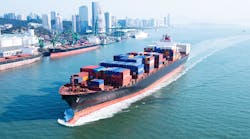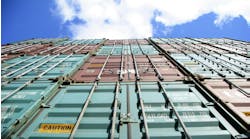Looking back to the 15th-century Age of Exploration, when vast uncharted areas of the ocean were marked Mare In Cognito, one might well ask if things have changed all that much despite the fact that 90% of all shipping now travels by ocean.
I ask because there’s far too much uncertainty about ships’ actual location and contents between the time they leave port until they’re unloaded at the destination. In 2018, 46 ships — some of which now stretch 1,300 feet long — were lost at sea, according to insurer Allianz (although that number was 55% below the 10-year average). According to industry trade group The World Shipping Council, an average of 1,390 containers yearly were lost at sea each year over the past three years (although that, too was lower than the prior period).The lack of real-time location data also contributes to problems unique to ocean shipping such as piracy, terrorism and drug running, and sensitive cargoes such as fruit or meats can be lost if a freezer problem goes undetected.
As Orbcomm, one IoT firm trying to bring real-time data reporting to shipping puts it, too much of the industry is “dumb, dark and disconnected.”
My attention was riveted on the maritime industry — and its sketchy record with modernization — by a Boston Globe Magazine article last summer, which asserted:
The modern maritime industry, responsible for moving $9 trillion of goods around the oceans every year, has been mostly ignored by policy makers, innovators, and venture capitalists … because shipping is slow to change, it will be the last major industry to undergo 21st century-style tech-driven disruption. When tech finally does take hold, the global consequences will be unprecedented.
Why is there such a data void with ocean shipping, especially since the IMO requires them to have satellite phones and GPS tracking? In part, that’s because (according to the Globe story) the operat0rs can order the devices unplugged. Seriously, can that willful lack of contact be tolerated in this day and age?
Not using proven technology to track the containers’ exact location (especially since they may be rerouted and/or delayed) and, equally important factors such as refrigeration, exposure to light, and unauthorized opening seems inexplicable, especially since FedEx introduced its pioneering SenseAware container back in 2009, to constantly track contents’ temperature, exposure to light and other conditions.
When you consider how it is used, the intermodal shipping container is ideally matched to the IoT’s real-time locational and status monitoring capacity, especially because the cargo is in the same container from the factory loading dock to the point of unloading after its sea and land journey is done. In industries such as food and pharma, the shipper can now have confidence in chain-of-custody, which can help reduce the costs of customers refusing shipments, etc, and build consumer confidence.
So why isn’t the IoT ubiquitous in the ocean shipping industry? In part, the explanation is cost of sensors and analytical tools, but experts say that can easily be brought down by higher adoption rates (lack of interoperability is sometimes also cited as an obstacle).
Denmark’s Maersk, by far the largest firm in the industry (moving 12 million containers a year), is trying to differentiate itself through an ambitious program to equip its 590 ships with state-of-the-art IoT-based reporting technology as well as equipment to precisely regulate the interior atmosphere and freezing equipment.
Its Remote Container Management 2.0 program parallels what jet turbine manufacturers do to allow real-time monitoring of planes both for predictive maintenance and to optimize performance. Shippers will gain peace of mind through the real-time data on the exact conditions of the individual containers they can access directly through its “Captain Peter” app for reefer containers.
Increasingly, new containers are built “smart,” with built-in monitoring technology, and other suppliers provide retrofit devices, some of which can be added in as little as ten minutes. Orbcomm provides sensors for 300,000 containers, not only for Maersk, but also WalMart, JB Hunt, and others. Other providers of varying combination of sensors and analytical tools include Arviem, EyeSeal,Loginno, Savi, SensorTransport, and Traxens.
The IoT also creates major opportunities for shipping firms to cut operating costs, since fuel costs can be as much as 50-60% of their operating costs, and manual container inspections onboard, which can be risky in bad weather, aren’t needed. As with the jet turbines I’ve written about before, the companies can combine real-time consumption data with ocean current and other data to plan the most efficient routes possible.
Equally important to increase ocean shipping’s efficiency is reducing the inherent chaos in ports, where you have many carriers converging, rail and train traffic added to the mix and unpredictable traffic surges when ships dock. A 2016 Atos report estimated that $400b yearly could be saved by better managing port infrastructures worldwide through better demand management and maintenance.
The Port of Hamburg, Germany’s busiest and one of the most crowded in Europe, has worked with SAP on IoT-based management systems.
140 million tons of cargo move through it yearly and up to 8,000 trucks arrive daily. Neither the docks or rails lines can be expanded. Hamburg created several “smartPORTS” to allow smooth flow of containers through a combination of cloud and real-time traffic management. Its smartPORT logistics platform runs on SAP’s Networked Logistics Hub, which in turn draws on data from the SAP HANA Cloud Platform.
This combination brings together data about every container, ship, and truck in the port, shared in real time, resulting in streamlined cargo handling. The system is so granular that not only do trucks get real-time advice on the best route to take, but also, when a truck will be held up at an open drawbridge the driver gets a discount coupon on his or her handheld for coffee at a place within walking distance!
IBM is the Port of Rotterdam’s IoT partner, with a goal of creating the “world’s smartest port,” installing sensors, AI, and do analysis of factors such as weather. It will eventually allow autonomous ships. They say the change can save shippers "up to one hour in berthing time, which can amount to about $80,000 per hour in savings."
Yet, to return to the issue of Mare In Cognito, let me conclude with the story of CargoMetrics, which is attempting to capture the growing volume of IoT-generated shipping data to create a comprehensible global picture of ocean shipping. It’s a real challenge, according to a 2019 article by CEO Dr. Scott Borgerson, “Bulk freight remains a voice-brokered, inefficient, gut-feel business with limited data-driven decision making.” One of the company’s charts makes a stark point: percentage of global freight “electronically transacted,” 0%!
The statistics I cited above about the significant reduction in loss of vessels and containers in the past three years gives cause for optimism, as well as the growing range of companies providing and buying IoT devices and analytics to track ocean shipping. However, the information is still too patchy and the switch to seamless data collection must fill many, many voids. Mariners, in those areas of uncertainty, you still must be aware: “There be dragons here!”
W. David Stephenson, principal of Stephenson Strategies (Millis, Massachusetts), is an IoT consultant and thought leader. His The Future Is Smart (HarperCollins Leadership), is one of the first books on IoT strategy.




